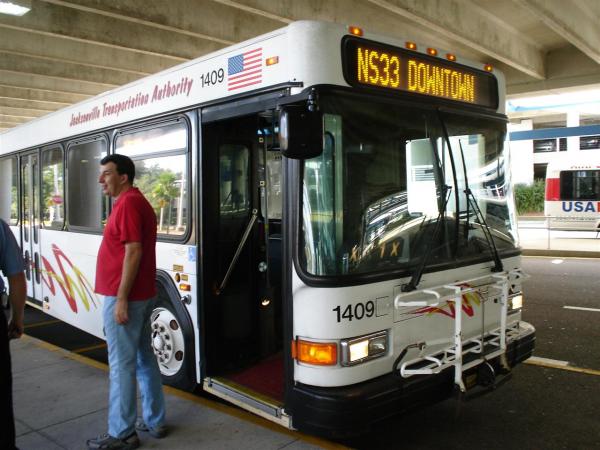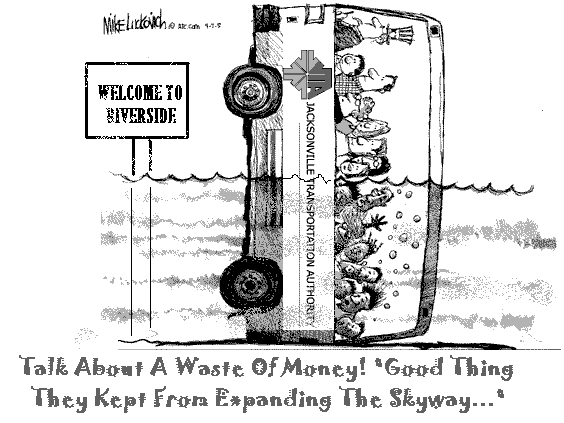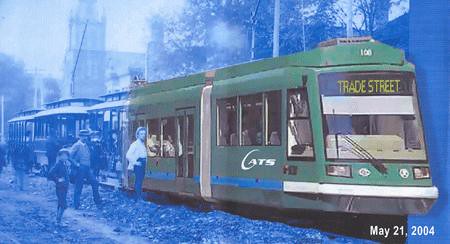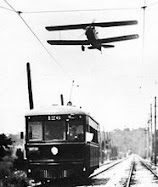 By Robert Mann
By Robert Mann
In Jacksonville for years the cry of the masses is that our "buses stink," they are dirty, filthy, smell like body odor of the unwashed masses, tattered, inept, unreliable, uncomfortable and often downright rude. A broken welfare transit system, home for the homeless, drug dealers and hookers, is certainly no place for an up and coming employee or executive.
But how true is that image? Has the transit of the masses been so neglected so as to sink into an irretrievable ninth circle of Hell?
Consider our role models, both our parents and relations. An editorial in Mass Transit Magazine last year looked at vacation season and asked if any of us had ever been on a public transit vacation? The author then took the extension to the extreme in stating that even Hollywood Movies and Recordings, avoid public transit in general, and buses in particular.
I had to say, I do remember traveling on a Greyhound Super-Scenic Cruiser sometime back in the early 1960's. As I recall, the passengers seemed to all share an obvious economic depression, but the polished driver sang all the way south. Helping little old ladies aboard, and overweight beach bums with their blankets and packs. The old route ran down Florida's scenic highway A-1-A from Jacksonville and the Beaches, to St. Augustine, Marineland, Flagler Beach to Daytona Beach. Often in easy sight of the Atlantic Ocean surf, or the many colorful shops and hotels that dotted it's route. But the whole experience had the cloud of some depressing due for the company axe, a prediction in my young mind, which turned out to be quite accurate. Almost every hamlet had it's stop, and it seemed to be well patronized in it's once daily, down and back schedule. Then one day, it simply was no more. It was as if the tides had washed it away like so many grains of beach sand. Driving the route some years later, I was listening to Harry Chapin's song "Take the Greyhound, it's a dog of a way to get around..."
A-1-A is much wider in most places today. The hotels are more grand, the restaurants are national and international chains. Even the tiny airport or two south of Jacksonville, are now regional jet ports. While Marineland and it's hotel have faded, St. Augustine and the dozen or so State and National Parks this little trip passed through sure haven't. In fact, when I made that trip, Jacksonville had a population of about 202,000 persons. Today the City is the third largest populated place in any of the east coast states.
So was it really Hollywood? Recall if you will that the "Bob Newhart," show, started and ended with stunning images of Chicago's CTA trains. Then there was Doctor "Patch Adams," who took the bus to find himself in a mental hospital. "Trains, Planes and Automobiles," and movies such as "Airplane," had us rolling on the floor laughing at the overall shortcomings of the transportation industry. Anyone remember Mr. Ralph Kramden? Ralph Kramden, played by Jackie Gleason, on the famous 1950's TV comedy, "The Honeymooners," Ralph was a bus driver for the fictional Gotham Bus Company. Though he was never seen driving a bus (except in publicity photos), but was shown multiple times at the bus depot. Ralph was frustrated by his lack of success, (apparently being a bus driver even carried a stigma in the 1950's) and often developed schemes designed to earn him and his wife a quick fortune. Ralph was very quick-tempered, and frequently resorted to insults and hollow threats of violence.
So while the Hollywood jury is still out on the bus business, our own local JTA has had a year of bad press. Bus drivers tossing passengers off the bus, fights over fares, refusal to carry passengers, complete lack of "ANY TIME" information, non-existent route maps, and now a roving Gnome who is blogging a journal of doom, "30 days with JTA," that will now be expanded to 90 days after a near fist fight with a cursing, irate, driver. The driver stopped at an unmarked stop across the street from a marked location. Perhaps the sign was simply missing, or perhaps for traffic reasons it was never placed. However JTA information told our stalwart passenger to flag down the bus. He did as he was told, and stepped aboard only to catch a full broadsides of foul language and demands that he get off the bus, walk the two miles to the next stop, or, the police would be called to eject him. As his journal has caused a constructive discourse with JTA management, he was immediately back on the cell phone to JTA information and soon talking with the supervisor.
Needless to say it got even more ugly when the driver still yelling, told him, "Oh I'm sure your talking to my boss, you can tell him to XXXX too!"
Is it an obvious case of "The Jacksonville Transportation Authority Stinks," with service boardering on the tenth circle of hell? Not at all. JTA is in transformation from a large southern city system, to an international city metro. Certainly there are bumps along the way, but managment is doing exactly what it should be doing with this case, this journal, this rider and information. It is meeting en-masse, and not just for damage control, but reaching for real solutions. Listening to what the public is saying. Sweeping changes are coming to the bus portion of JTA, and I'm confident they will be quickly followed by monorail (The Jacksonville Skyway), light rail and commuter rail, additions and improvements. Things happen for a reason, and no matter how beautiful the new Gillig BRT model buses, if the driver's attitude chases away the would-be patrons, then the bus "stinks".
Our solution is not simply that new vehicle smell on the same old machine, but a complete re-thinking of the industry. Out of the Box, and even perhaps out of the old bounds. There is that route down A-1-A just waiting for some lucky service to pick it up and market those beach side resorts. This is Florida's First Coast, home of the nations oldest city. Today all of that falls within the bounds of the Jacksonville Metro Area and the potential reach of JTA or a joint venture of JTA and another franchise, such as Trailways or a charter carrier. We are talking fare free in Jacksonville, preboarding tickets or passes, fun buses, day trips, and maybe even singing drivers. All along the booming coast we have construction, new jobs and massive port expansion. Home to more fortune 500 companies then any other two Florida Cities combined, we have a new, urban and financially powerful workforce. There is national exposure in our Arena and Arts, and our NFL Jaguars or the home of the PGA at Sawgrass, have changed our posture. No longer can we afford to operate the old bus system of the past and JTA knows it. We still have miles upon mile of untouched roadway, and untouched beach sand... I say it's time that Jacksonville and JTA build some castles in the sand. Any of you old enough to remember the Chapin Greyhound song, will recall, he ended it in reflection of his bus trip... "A thought for keeping if I could, It's got to be the going not the getting there that's good."











































